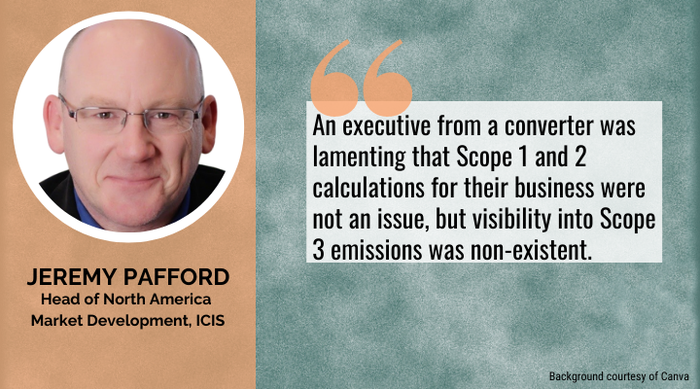Advice for plastics stakeholders as the SEC proposes registered companies report greenhouse gas (GHG) emissions aka carbon footprint.
May 18, 2022

Lunchtime conversation topics at a plastics industry event typically center on business conditions, technological advances, or recent family vacations. A crafty conversationalist can weave all three topics into a narrative.
The spring board meeting held in early May in Chicago by the Plastics Industry Association (PLASTICS) saw the growth of another topic that is permeating into discussions at mealtime, in boardrooms and in dealings with suppliers and customers up and down the supply chain — carbon footprints.
Earlier this year, the Securities and Exchange Commission (SEC) proposed rule changes that, if enacted, will require companies registered with it (which includes publicly traded companies as well as a good number of private ones) to disclose an assortment of climate-related risks to the business as well as information about its direct, indirect, and value chain greenhouse gas (GHG) emissions.
According to the SEC, “(t)hese proposals for GHG emissions disclosures would provide investors with decision-useful information to assess a registrant’s exposure to, and management of, climate-related risks, and in particular transition risks.”
The SEC introduced the proposal in March and has extended the public comment period to June 1; you can read what has been submitted and submit your own here. Following the public’s say, the SEC will consider that input before deciding whether to publish a formal, binding rule in the Federal Register.
Figuring out Scope 1, 2, and 3 emissions
This SEC proposal is not happening in a vacuum – the European Commission adopted in 2021 its Carbon Border Adjustment Mechanism for imports of certain products, and many companies who operate globally or regionally have been increasingly focused on the carbon footprints of their operations. Figuring out GHG emissions from direct operations (called Scope 1 emissions) and from indirect emissions from purchased energy such as electricity (called Scope 2) is a relatively straightforward set of tasks, at least compared to adding up the carbon footprint from the upstream value chain (called Scope 3).
If you are a converter of polypropylene (PP) resin, you should be able to figure out the Scope 1 carbon emissions from your processing of pellets into a molded part or container. Obtaining a Scope 2 footprint from your electricity provider may be similarly easy.
But what about visibility into all the carbon used to make those PP pellets, the Scope 3 emissions? Those pellets did not magically appear out of thin air — the molecules originally came from sources such as a barrel of crude oil or propane gas buried deep in the ground that was extracted and transformed into propylene and then into PP.
A variety of processes took place upstream to make that pellet, all of which have a carbon footprint. Figuring that out on your own would be time-consuming at best and near impossible for most, because there is not a one-size-fits-all answer to the Scope 3 carbon footprint of a carbon pellet. It varies quite a bit globally, with the lowest carbon footprint at 1 kilogram (kg) of carbon dioxide (CO2) per kg of PP and the highest at 10.4 kg per kg of PP — a 91% difference. That difference matters a great deal, since 68% of a product’s carbon footprint comes from the supply chain — Scope 3 emissions — while only 32% come from the Scope 1 and 2 realms of a manufacturer’s own processes and energy use.

Carbon Minds solution to an industry lament.
Which brings us back to the lunchtime conversation at the PLASTICS board meeting. An executive from a converter was lamenting to another conversant that Scope 1 and 2 calculations for their business were not an issue, but visibility into Scope 3 emissions was non-existent. Similar refrains have emerged in conversations among brand owners, resin producers and beyond, especially those with public pledges towards being carbon neutral.
But that muddled picture is becoming a lot clearer thanks to a partnership between Independent Commodity Information Services (ICIS) and Carbon Minds that is set to offer visibility into Scope 3 carbon footprints for scores of chemicals and polymers such as PP, polyethylene (PE), polyethylene terephthalate (PET) and more. The collaboration is bringing to market this summer a Supplier Carbon Footprint product that brings to light the carbon emissions of chemicals and polymers down to the upstream plant level. In fact, the PP carbon footprint data referred to above comes from that analysis.
Supplier Carbon Footprint data will support more accurate emissions assessment, identification of opportunities to find alternatives with lower emissions, and benchmark their Scope 3 emissions against their competitors. It also will move the ball forward on those lunchtime conference conversations over emissions, turning them from ones centered on inability to see the full picture to ones focused on the opportunities to best evolve the supply chain in a carbon-focused world.
Jeremy Pafford, head of North America market development, drives ICIS’s business development strategy for the US, Mexico and Canada and represents ICIS to chemical and polymer markets to showcase the company’s expertise. Pafford draws upon experience in leading engagement efforts by the Americas team over the last several years.
About the Author(s)
You May Also Like




